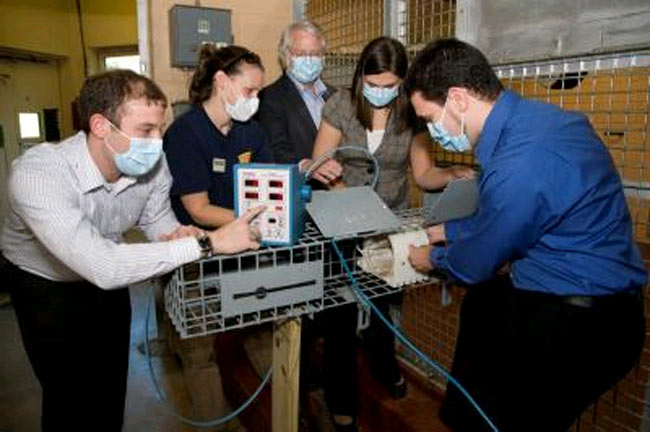How to Take a Gorilla's Blood Pressure: Very Carefully

Humans can be difficult enough patients, but try a 300-pound gorilla.
Using a new device, researchers have obtained the first ever blood pressure reading from a gorilla while the animal was actually awake. The device, called the Gorilla Tough Cuff, could help veterinarians to better assess the health of their gorillas.
Just like people, gorillas can develop heart problems. In fact, cardiac disease is the leading cause of death for captive adult male gorillas.
While veterinarians can check the animals for high blood pressure, a warning sign of the disease, up until now all readings had to take place while the gorilla was anesthetized using a cuff originally designed measure human thigh blood pressure. Handlers needed to knock the gorillas out because the animals were unlikely to want to stick their arms outside their cages and have them warped with something, since such movements may scare them. But anesthesia affects blood pressure, and the measurements taken from unconscious gorillas may be inaccurate.
A team of undergraduates from Georgia Tech and Emory University attempted to solve this problem as part of a senior project in biomedical engineering.
To work on an awake and alert gorilla, their blood pressure reading system would need to take into account gorilla strength and their tendency to scare easily, said David Sotto, a member of the team who is now a graduate student at Georgia Tech.
"One of the biggest challenges is actually gorilla's skittish nature," Sotto said. "They're very easily frightened, and when they get frightened, they'll definitely break anything that's attached to them or anything that's making them feel uncomfortable."
Get the world’s most fascinating discoveries delivered straight to your inbox.
The team's device works in a very similar way to the blood pressure systems you see at the doctor's office. The large primate needs to slip its arm into a cuff, the cuff inflates, and the blood pressure is measured and then displayed on a monitor.
However, with the Gorilla Tough Cuff, the cuff, or inflatable "bladder," is bolted to the inside of hollow plastic casing. The plastic casing is, in turn, attached to a small cage that can be temporarily connected to the animal's larger cage. The gorilla places its arm into the small cage and through the cuff. The animal can also grip a steel dowel that is affixed to the end of the device.
The cuff is hooked up to a blood pressure monitor that is kept outside the cage.
This new setup avoids any direct contact between gorilla and handler, and the cuff does not need to be fastened to the primate's arm.
The device was first tested on a 48-year-old gorilla named Ozzie from Zoo Atlanta, a feat that took months of positive reinforcement training.
"Zoo Atlanta is home to the nation's largest collection of gorillas, so there is an ongoing responsibility to contribute to the zoological community's understanding of their care," Dennis Kelly, president and CEO of the zoo, said in a statement. "We are proud to have spearheaded an effort that will ultimately benefit gorillas living in captive settings around the world."
The student team, which included David Sotto, Nisha Bhatia, Stephanie Drewicz and Scott Seaman, constructed their blood pressure system with the help of Hanjoong Jo and Franklin Bost, both professors at the Wallace H. Coulter Department of Biomedical Engineering at Georgia Tech and Emory University.
- 10 Deadliest Animals
- Video - Laughing Apes
- All About Primates

Rachael is a Live Science contributor, and was a former channel editor and senior writer for Live Science between 2010 and 2022. She has a master's degree in journalism from New York University's Science, Health and Environmental Reporting Program. She also holds a B.S. in molecular biology and an M.S. in biology from the University of California, San Diego. Her work has appeared in Scienceline, The Washington Post and Scientific American.


